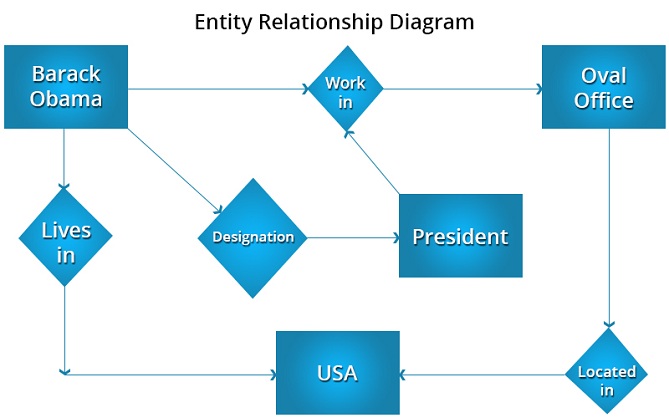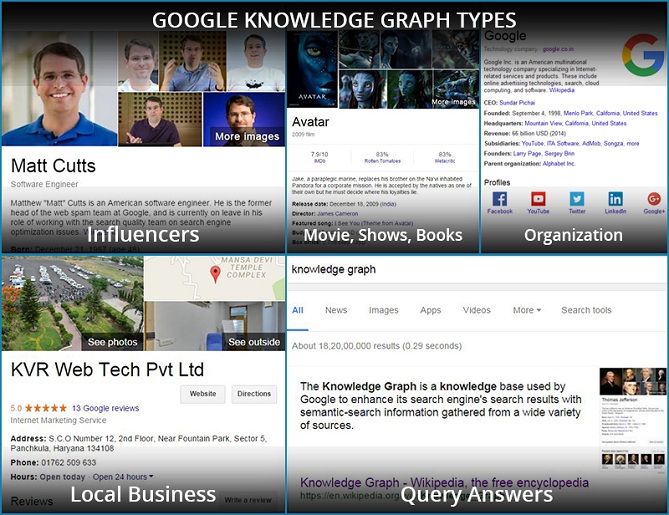
Since its introduction in 2012, Google’s Knowledge Graph has begun to alter the way in which Google’s search engine provides information to people. According to Google, when people perform a search they’re not simply looking for a website. Rather, they’re looking for answers and understanding. Knowledge Graph is a way for Google to provide information that is more meaningful and useful to those making the search.

Knowledge Graph also represents a great opportunity to people, businesses, and websites that want to be discovered. Because different users almost never receive identical SERPs, traditional ranking schemes are beginning to lose their dominance. Getting content into Google’s Knowledge Graph is a great way to ensure visibility and establish authority. May be this is the reason that Google is proactively encouraging businesses to keep their Google Knowledge Graph profile up-to-date for better visibility.
Before we dive into the different ways to get your business on Google Knowledge Graph, we should cover the basics of what Knowledge Graph is, including what it does, how it works, and how it is revolutionizing traditional search engine results.
What is Knowledge Graph?
The first thing to understand about Knowledge Graph is that its intention is not only to simply provide searchers with high quality links, but also to provide relevant data and answers for searchers as well. Knowledge Graph does this through semantic search just like the way our mind adapts, operates, and responds back to things which happens around us. Just like the example shown below:

Semantic search attempts to understand both the intent of the search and its context to provide a more accurate and useful result.
If you’re wondering how this is different from a typical results page, see this process in action by searching for “weather” or “auto shop” in Google. When you do so, you’ll notice a box at the top of the page that lists local weather information and local auto repair shops.

This box displays Knowledge Graph results. These results are located right at the top of the page and highlighted by a box, all of which beg for these results to be looked at. Furthermore, Knowledge Graph displays information in a format that is easy to assimilate and often provides meaningfully related results.
Meaningful Results
These results are based on a semantic search of information related to the searcher and the intent of their query rather than a desire to simply return the most keyword-and backlink-rich websites that Google can find. In other words, Google is attempting to give searchers meaningful results based on relationships between ideas, and not just based on which website is ranked the highest.
At its core, Knowledge Graph isn’t just about delivering better results—it’s also about understanding what people are searching for. Knowledge Graph is responsible for the autocompletion aspect of your initial search, answering one of life’s most mysterious questions: where the different search recommendations come from when you start typing the first letters of your query. This is no more than Knowledge Graph at work, predicting your question based on a number of proprietary algorithms.
A New Search
As you can imagine, Knowledge Graph is changing the way Google returns results for search queries. Because the purpose of Knowledge Graph is to return results that have real meaning for searchers based on intuitive, semantic search algorithms, traditional keyword and backlink search optimization may become less impactful in the future.
One way in which Knowledge Graph strives to provide relevant information is through its “Entity Relationship” model, which shares topics and entities closely related to the subject searched.
Below is a simple Entity Relationship Diagram:

While “Barack Obama,” “Oval Office,” “USA,” and “President” are entities here, they are related to each other through relationships: “Work In,” “Located In,” “Lives In,” and “Designation.”
The purpose of Knowledge Graph isn’t to limit SEO practices, but rather to provide a better service for Google users. That said, Knowledge Graph is not specifically designed to help (or hurt) businesses, but that doesn’t mean that you can’t benefit from it.
Google Knowledge Graph falls in following five categories

How to Get Your Business on Knowledge Graph
At first glance it may seem like only celebrities, public and historic figures, big brands, and large corporations will be able to benefit from Knowledge Graph, but that’s far from the truth. While you can’t control what Knowledge Graph displays about your company in the same way that you can alter metadata, there are still ways to influence these results. Here are a few ways you can help Google generate a Knowledge Graph for your business.
1) Create a Wikipedia Page
Wikipedia is one of the most visited websites in the world. Its information is considered to be fairly accurate and as such is highly trusted by search engines like Google. For example, if you look at the Knowledge Graph for George Washington you’ll see that the information used to fill it is being pulled from Wikipedia.
Because most Wikipedia articles contain a high number of quality links, are generally better researched, and are more reliably cited than other sources, its content has more meaning for knowledge-based systems that search out relationship and connection. As such, you should consider creating a Wikipedia page for your business.
Of course, Wikipedia pages require your topic to be of importance, while providing useful information— otherwise, they may be deleted, which is why you should provide some resources that demonstrate value and authority. Links to articles in respected sites will help your Wikipedia page have lasting power.
2) Use Schema Markup
Schema markup is code, so it’s not for the faint of heart or the unqualified. Schema HTML codes are written for the algorithms used by major search engines like Google. Search engines read Schema code and gather context and information about your website.
According to Joel Gross at Coalition Technologies, the infrastructure of your HTML code is vitally important to how search engines crawl your data. Properly using Schema makes it easier for Google to create a clear image of your website and your business. It is also more likely that a Knowledge Graph of your company would include data marked by Schema.
You can mark up all kinds of items, including products, places, organizations, individual, events, and even recipes.

3) Online Business Detail Submissions
By December 2014, plans were underway to shutter Freebase, Google’s proprietary database from which Knowledge Base pulled. Wikidata has now completely replaced Freebase, which makes it imperative to utilize the service should you want to have a knowledge base sidebar— particularly should your company have no Wikipedia entry. Wikidata can help fill in Knowledge Graph boxes with info about your company details or type.
To get started, one must create a profile on wikidata.org. The Schema markup mentioned above will need to be implemented. Although anyone can create their own page on Wikidata, there are an abundance of guidelines to follow, enforced by moderators. Therefore, do not post anything fictitious, or that creates a conflict of interest.
The CIA World Factbook is another third-party source that Google is likely to pull from. However, keep cognizant that the World Factbook is not capable of being edited or modified by users, which severely limits anything you can personally contribute.
4) Get on Local Listings
One of the most useful components of Knowledge Graph is the local listing element. When you searched for the term “auto shop” earlier, the Knowledge Graph box displayed listings of auto repair shops in your area. As such, local search is a great way to get noticed by people in your area.
The first step to being featured as a local listing is to ensure that your business name, address, and phone number are consistently listed across all of your online platforms, such as your website and your social media accounts. You have a better chance of being listed if your information is uniform across all channels.
Next, submit your business to local directories and websites like Bing Places, Yelp, Yellow Pages, Foursquare. An additional overlooked, but vital avenue is your local Chamber of Commerce.
Finally, make sure you take advantage of all of Google’s business offerings. It only makes sense to list your business on Google Maps, Google+ Local, and Google My Business. You should probably have a Google+ account too.
5) Start a Google+ Page
Although it’s fairly intuitive, it’s worth mentioning again: if you don’t have one already, you should start a Google+ page for your business. Knowledge Graph already pulls images, posts, and other information from Google+, so it’s extra beneficial for your business to have an active profile on Google’s social platform as this is the era of social media and social media engagements can boost up your business growth easily.
Benefits of having Business in Google Knowledge Graph
You may be asking yourself, just what are the benefits of having your business listed on Google’s Knowledge Graph? The simple answer is exposure. Knowledge Graph represents a new paradigm for search result listings. Search results are shifting away from static website rankings toward a more comprehensive and meaningful interaction replete with the intent, context, and desire of searchers.
By following proven steps to get your business listed on Knowledge Graph, you can help your business stay relevant to potential customers searching for goods and services that you provide. What’s more is that the Knowledge Graph has the ability to list much more than just your website address. It can provide images, hours of operation, reviews, and even your latest blog or social media posts. In other words, it gives searchers a holistic view of your business.
Knowledge Graph Is Just Beginning
Google’s Knowledge Graph isn’t going away— in fact, it’s just getting started. Google is actively creating a more intuitive search experience for its users. Knowledge Graph has already been implemented on desktop, tablet, and mobile searches and Google is adding more Knowledge Graphs to search results every single day.
As the functionality of this algorithm improves over time, Knowledge Graph will become an increasingly important aspect of what Google does. According to Google, the company is in the beginning phases of shifting from being an information engine to becoming a knowledge engine, and that’s an important distinction for users and SEO strategists alike.
By connecting the information that’s on the web with the intent of user’s queries, Google is able to provide richer results that offer substantive meaning to searchers. You can help aid this process by taking the aforementioned steps to ensure that your website is optimized to be read by Google’s Knowledge Graph.
While there is no guarantee that your site will be included in a Knowledge Graph, it’s important for your business to start taking the right steps to help it get there as soon as possible.
Author Bio: Carolyn Clarke is a freelance tech writer from West Hollywood, CA. Her works have been published across many media outlets, including Digital Media. She is a self-proclaimed tech geek and loves to find out about new technology, games, and literature.

Started working as a digital marketing expert, Varun Sharma is now also a well-known digital marketing speaker – a speaker on performance development, and a trusted mentor to businesses in the digital world. His keynote expositions are based on the digital marketing theories, which provide a fascinating insight into the secrets of high performance.

